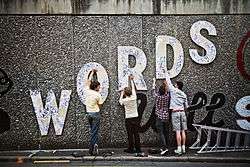Zephyr (artist)
| Zephyr | |
|---|---|
.jpg) Zephyr in 2006 | |
| Nationality | American |
| Known for | Graffiti |
| Notable work | Wild Style logo |
ZEPHYR, born Andrew Witten, is a graffiti artist, lecturer and author from New York City. He began creating graffiti in 1975 and first signed using the name "Zephyr" in 1977. He has been identified as a graffiti "elder", who along with Futura 2000, Blade, PHASE 2, CASH, Lady Pink and TAKI 183 invented styles and standards which are still in use.[1]
Graffiti
Much of Zephyr's original work was graffiti applied on New York City Subway rolling stock. Witten has commented on this period of his work:
We felt we understood the trains more than the Transit Authority. Teenagers were running the system. We decided when, where, how much we wrote. Graffiti showed that the Transit Authority was not in control.[2]
Witten was part of the first wave of graffiti artists to make the transition to galleries, collectors and commercial work. In the early 80s, he showed at New York City galleries specialized in graffiti, such as the FUN Gallery and 51X.[3] His art was part of a five-man show including Fab Five Freddy, Dominique Philbert, Futura 2000 and Dondi White that toured Japan in 1983.[4] In 2005, he was included in the "East Village USA" show held at The New Museum.[5]
His works can be seen in the hip-hop culture documentary Style Wars and he was featured as himself in the landmark hip-hop motion picture Wild Style. He is co-author of a 2001 biography of fellow graffiti artist, Dondi White: Dondi White Style Master General: The Life of Graffiti Artist Dondi White. He is interviewed in the 2005 DIY graffiti video The Art of Storytelling, where he talks about fallen graffiti artist Nace. He was featured in the documentary Bomb It.
His name was inspired by a brand of surfboards and skateboards.[6] Many of his most popular pieces have been done by simply redesigning his trademark name "Zeph" or "Zephyr". Sharp contrast in the edges of the letters are also featured throughout his artwork.
Witten's influence on New York City's self-image is exemplified in Suzanne Vega's 2007 song "Zephyr and I," which uses a conversation between Vega and Witten as a framing device to create what Vega describes as "sort of a little snapshot of what West End Avenue used to be like in the 70s."[7]
Published works
- Witten, Andrew; White, Michael. Dondi White Style Master General: The Life of Graffiti Artist Dondi White. Regan Books: 2001.
- Cooper, Martha; Walta, Akim; Zephyr; Ahearn, Charlie; Fabel; Astor, Patti. Hip Hop Files: Photographs 1979–1984. From Here to Fame (Powerhouse Books): 2004.
- Zephyr; Miller, Ken; Sutherland, Peter. Pedal. Powerhouse Books: 2006.
- Powell, Ricky. Zephyr (illustrator). Oh Snap 2.13.61 Publications: 1996. also had tons of lips
References
Notes
- ↑ Janice Rahn, Painting Without Permission: Hip-Hop Graffiti Subculture, Bergin & Garvey: 2002, pg. 7.
- ↑ John Leland, "At Home with Futura: For a King of Krylon, the Family Reigns", The New York Times, Sec: House + Home, March 1, 2001, Pg. 1.
- ↑ Patty Astor online interview, www.@149st.com, 2002 online link
- ↑ UPI, "5 Artists take graffiti from the streets to the galleries", The Philadelphia Inquirer, March 19, 1984.
- ↑ Exhibition notes, East Village USA, New Museum of Contemporary Art, December 9, 2004- March 19, 2005 Online link Archived November 12, 2006, at the Wayback Machine.
- ↑ "Interview with Zephyr".
- ↑ Interview, 07/11/2007. Online link Archived September 28, 2007, at the Wayback Machine.
Further reading
- Philbert, Dominique (March 19, 1984). "UPI: 5 Artists take graffiti from the streets to the galleries". The Philadelphia Inquirer.
- Staff, Herald (November 30, 1984). "Biscayne baby changes color with graffiti". The Miami Herald.
